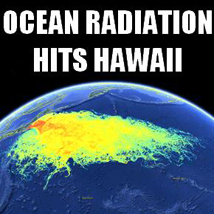Ocean Radiation Plume Hits Hawaii From Fukushima Nuclear Meltdown
 The latest marine radiation plume simulation from ASR LTD shows that the radioactive contamination from the Fukushima nuclear meltdown has now reached norther Hawaii.
The latest marine radiation plume simulation from ASR LTD shows that the radioactive contamination from the Fukushima nuclear meltdown has now reached norther Hawaii.This should be no surprise, since it was originally disclosed shortly after the disaster that the plume would reach Hawaii within about 1 year and California in 2 to 3 years when the government decided not to test fish at that time.
Please note this simulation, as explained below, shows only the extent of where the particles in radioactive plume have traveled.
It does not attempt to estimate the dilution of the radiation since such estimates are currently impossible due to refusal by TEPCO and the government of Japan to release critical scientific data required to calculate the concentration of the plume.
Also note that the simulation only takes into account the million gallons of radioactive water TEPCO purposefully dumped into the ocean.
That water was later found to have been 7.5 million times the legal limit and the dumping was done after TEPCO was were “Stongly urged to do so by the US government.
Since then TEPCO has reported on numerous occasions they lacked on-site storage space and may need to dump even more radioactive waste into the Pacific ocean.
The simulation also doesn’t account for any of the “run-off” radiation from TEPCO spraying the reactors with water cannons to keep the nuclear fuel cool.
It can not account for any contamination in the ocean from pieces of the nuclear fuel rods that were scattered all over the area after a series of massive explosions at the plant.
It does not account for the run off of radioactive sewage which is piling up all over Japan which runs off into the ocean and has resulted in a layer of cesium sludge on the bottom Tokyo bay which is now over 10 inches thick.
It can not account for the cloud of nuclear ash that rains down on country from numerous incinerators being used to dispose radioactive waste by burning it.
US government officials will surely downplay this latest development given the previous statements such as there is no concern to human life from eating fish with radiation 24 times FDA radiation limits and the EPA switched from their own standard of radiation which allows for cancer fatalities in 1 out of a million to an FDA standard which allows for fatalities from cancer in 1 in 2,200.
ASR reports:
Radioactive Seawater Impact Map (update: March 2012)We use a Lagrangian particles dispersal method to track where free floating material (fish larvae, algae, phytoplankton, zooplankton…) present in the sea water near the damaged Fukushima Daiichi nuclear power station plant could have gone since the earthquake on March 11th. THIS IS NOT A REPRESENTATION OF THE RADIOACTIVE PLUME CONCENTRATION. Since we do not know exactly how much contaminated water and at what concentration was released into the ocean, it is impossible to estimate the extent and dilution of the plume. However, field monitoring by TEPCO showed concentration of radioactive Iodine and Cesium higher than the legal limit during the next two months following the event (with a peak at more than 100 Bq/cm3 early April 2011 for I-131 as shown by the following picture).
Assuming that a part of the passive biomass could have been contaminated in the area, we are trying to track where the radionuclides are spreading as it will eventually climb up the food chain. The computer simulation presented here is obtained by continuously releasing particles at the site during the 2 months folllowing the earthquake and then by tracing the path of these particles. The dispersal model is ASR’s Pol3DD. The model is forced by hydrodynamic data from the HYCOM/NCODA system which provides on a weekly basis, daily oceanic current in the world ocean. The resolution in this part of the Pacific Ocean is around 8km x 8km cells. We are treating only the sea surface currents. The dispersal model keeps a trace of their visits in the model cells. The results here are expressed in number of visit per surface area of material which has been in contact at least once with the highly concentrated radioactive water.
Source: ASR Limited
The Fukushima Diary posted the following screen shots of the ocean radiation plume simulation.
You can return to the main Market News page, or press the Back button on your browser.



